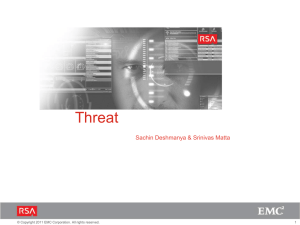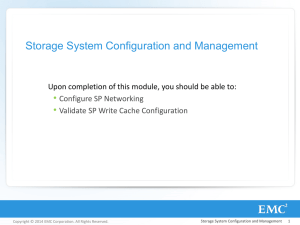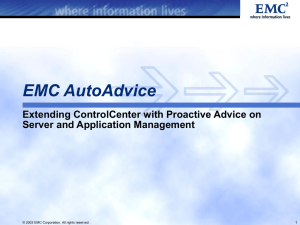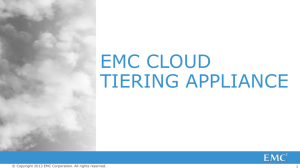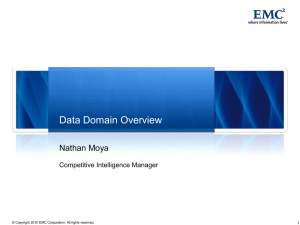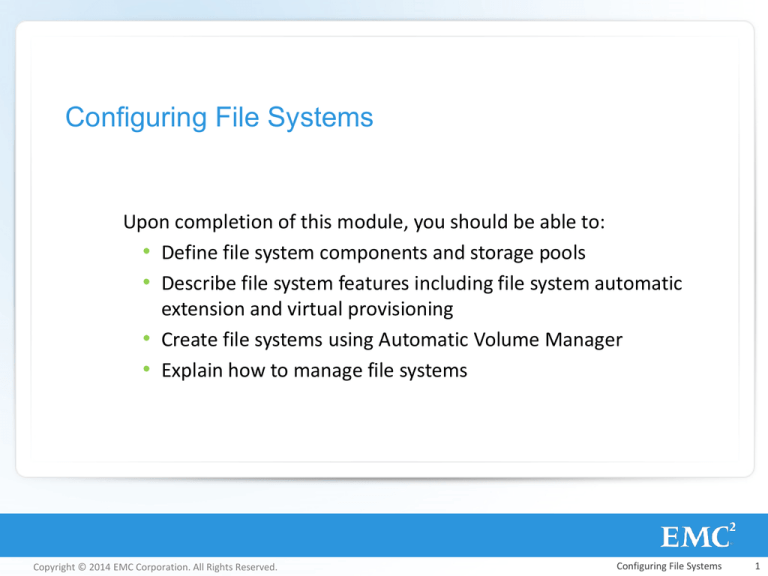
Configuring File Systems
Upon completion of this module, you should be able to:
• Define file system components and storage pools
• Describe file system features including file system automatic
extension and virtual provisioning
• Create file systems using Automatic Volume Manager
• Explain how to manage file systems
Copyright © 2014 EMC Corporation. All Rights Reserved.
Configuring File Systems
1
Configuring File Systems
Lesson 1: UxFS File System
This lesson covers the following topics:
• UxFS file system
• Automatic Volume Manager (AVM)
• Storage pools
Copyright © 2014 EMC Corporation. All Rights Reserved.
Configuring File Systems
2
VNX File System Overview
• Method of cataloging and managing files and directories on a
storage system
• VNX for File uses UxFS file system
Groups file data with its metadata for an
improved locality of reference
• VNX file systems can be created
automatically or manually
Copyright © 2014 EMC Corporation. All Rights Reserved.
Configuring File Systems
3
Creating File Systems Automatically
• Automatic Volume Manager (AVM) is a feature used to create
VNX file systems automatically
The AVM algorithm creates the underlying file system structure
Automatic Volume
Management
• Provides an easy to use
method of creating and
managing file systems
• Maximizes capacity and
improves client performance
Manual
• Application requires precise
placement of file systems on
particular disks
• Provides more control over
storage allocation
* We will be covering file systems via AVM in this module
Copyright © 2014 EMC Corporation. All Rights Reserved.
Configuring File Systems
4
AVM File System Structure
File System
Metavolume
Slice
Stripe
Disk
Volumes
(dVol)
Copyright © 2014 EMC Corporation. All Rights Reserved.
Configuring File Systems
5
File System Components: dVols
• The underlying storage for all other volume types
• Disk volumes are created when LUNs are presented to the VNX
for File via:
The file storage provisioning wizard
Adding LUNs to ~filestorage storage group
• Each dVol maps to a LUN on the storage system
LUNs may come from RAID Groups or Block storage pools
LUN 207
LUN 208
Copyright © 2014 EMC Corporation. All Rights Reserved.
dvol 21
dvol 22
Configuring File Systems
6
File System Components: Stripe Volumes
• Volumes are stripped together and presented as one logical
•
•
volume
Achieve greater performance and higher aggregate throughput
AVM decides on the number of dVols to stripe depending on the
LUN type
Up to 4 dVols when RAID Group LUNs are used
Up to 5 dVols when Pool LUNs are used
Stripe
Volume
80 GB
dvol 21
20 GB
dvol 19
20 GB
Copyright © 2014 EMC Corporation. All Rights Reserved.
dvol 10
20 GB
dvol 12
20 GB
Configuring File Systems
7
File System Components: Slice Volumes
• Method of making smaller volumes from larger volumes
• Satisfies a file system request without utilizing the entire stripe
volume
Space left over on the stripe volume can be used for other file
systems
• Slicing is the default when creating file systems
Slice Volume
20 GB
Stripe Volume
80 GB
Copyright © 2014 EMC Corporation. All Rights Reserved.
Configuring File Systems
8
File System Components: Metavolume
• A metavolume is a concatenation of one or more volumes
• In order to create a file system, a metavolume must first exist
• A file system is able to dynamically expand by adding more
volumes to the metavolume
File System 20 GB
Slice 20 GB
Metavolume
Slice 30 GB
Metavolume
Copyright © 2014 EMC Corporation. All Rights Reserved.
File System 30 GB
Configuring File Systems
9
Disk Volume Types
• Disk volumes are categorized in AVM by the physical disk associated
with the LUN and the LUN type
Disk Type
Description
CLSAS
VNX Block SAS drives (including NL-SAS)
CLEFD
VNX Block Performance and SATA II Flash drives
Capacity
VNX Block pool LUNs from NL-SAS disks
Performance
VNX Block pool LUNs from SAS disks
Mixed
VNX Block pool LUNs from mixed disk types
* Complete Disk Types listing in Managing Volumes and File Systems with VNX™
AVM product document
Copyright © 2014 EMC Corporation. All Rights Reserved.
Configuring File Systems
10
AVM Storage Pools
• Storage pools are containers that hold stripe volumes ready for
•
use by AVM
Storage pools with RAID Group LUNs
System-defined pools
256 KB stripe element size
User-defined pools
• Storage pools with Pool LUNs
Member Volumes
Mapped pools
Stripe 1
80 GB
Stripe 2
80 GB
Storage Pool = 160 GB
Copyright © 2014 EMC Corporation. All Rights Reserved.
Configuring File Systems
11
System-defined Pools
SAS Drives - CLSAS
Pool
RAID Config
clarsas_archive
3+1, 4+1, 6+1, 8+1 RAID 5
clarsas_r6
4+2, 6+2, 12+2 RAID 6
clarsas_r10
1+1 RAID 1/0
Flash Drives - CLEFD
Pool
RAID Config
clarefd_r5
4+1, 8+1 RAID 5
clarefd_r10
1+1 RAID 1/0
Copyright © 2014 EMC Corporation. All Rights Reserved.
Configuring File Systems
12
Mapped Pools
• When Pool LUNs are presented to the VNX File, a mapped pool is
created by AVM
The mapped pool is deleted when all Pool LUNs are removed from
the ~filestorage group
Advanced Block storage features such as FAST-VP, Thin LUNs and
Compression are supported
Mapped
Pool
1:1
Copyright © 2014 EMC Corporation. All Rights Reserved.
Configuring File Systems
13
Striping with Pool LUNs
• Before striping, AVM will divide available Pool LUNs/dVols in
•
•
Thick and Thin groups
All Thick LUNs will be used first before using any Thin LUNs
Up to 5 dVols of the same size, data services, and SP balanced
will be striped, with a minimum of two
First 5
Then 3
Stripe
Stripe
Copyright © 2014 EMC Corporation. All Rights Reserved.
Then 4
Then 2
Stripe
Stripe
Configuring File Systems
14
Concatenating with Pool LUNs
• If AVM can’t find available LUNs of the same size for striping,
then:
Concatenate enough Thick LUNs to meet size requirements
LUN1
LUN1
LUN2
LUN2
If no Thick LUNs are available, use Thin LUNs
LUN 1
LUN 1
LUN 2
LUN 2
If not possible, put Thick and Thin together
LUN1
LUN 2
• If that is not possible, file system creation/extension fails!
Copyright © 2014 EMC Corporation. All Rights Reserved.
Configuring File Systems
15
AVM Considerations
• All volumes of a file system must be stored on the same storage
•
system
AVM storage pools must contain only one disk type and cannot
be mixed, unless if using Pool LUNs
• When creating Pool LUNs:
Pool LUN count should be divisible by 5 to assist AVM striping
Balance SP ownership
• If File Thin Provisioning is desired, use a Thin Enabled file system
on RAID Group LUNs or Thick LUNs, instead of Thin LUNs
Copyright © 2014 EMC Corporation. All Rights Reserved.
Configuring File Systems
16
Configuring File Systems
Lesson 1: Summary
During this lesson the following topics were covered:
• UxFS file system
• Automatic Volume Manager (AVM)
• Storage pools
Copyright © 2014 EMC Corporation. All Rights Reserved.
Configuring File Systems
17
Configuring File Systems
Lesson 2: File System Features
This lesson covers the following topics:
• VNX automatic file system extension feature
• VNX file system thin provisioning feature
• File system deduplication
• Provisioning Monitoring
Copyright © 2014 EMC Corporation. All Rights Reserved.
Configuring File Systems
18
Auto Extend Overview
• AVM automatically extends a file system based on High Water Mark
Enabled at creation time or at a later time via the file system properties
page
Copyright © 2014 EMC Corporation. All Rights Reserved.
Configuring File Systems
19
File System Extension Process
• Another slice is taken from the same stripe volume, if possible, to
create another metavolume
File System
v110
20 GB meta
v117
20 GB meta
s69
20 GB slice
s71
20 GB slice
v107
80 GB stripe
Copyright © 2014 EMC Corporation. All Rights Reserved.
Configuring File Systems
20
Auto Extend Considerations
• All file system commands are blocked until file system extension
is complete
• Auto extend options may only be modified if file system is
mounted read/write on the Data Mover
• Enabling automatic file system extension does not reserve space
in the storage pool
Administrators need to ensure there is enough space in the pool
for file system extension
Copyright © 2014 EMC Corporation. All Rights Reserved.
Configuring File Systems
21
Thin Provisioning Overview
• Allocate file system storage on a need basis
File system grows on demand as data is being written
• Auto Extend must be enabled to use thin provisioning on a file
system
Max Capacity must be specified
• NFS/CIFS clients and applications will see the virtual maximum
size instead of the actual allocated size
Copyright © 2014 EMC Corporation. All Rights Reserved.
Configuring File Systems
22
Configuring Thin Provisioning
Copyright © 2014 EMC Corporation. All Rights Reserved.
Configuring File Systems
23
File Deduplication Overview
• Deduplicate and compress
redundant data at the file-level
If two or more files are
identical, only one instance of
the file will be used
Increased storage efficiency
• File system must have at least
•
1 MB of free space
Active files will not be
deduplicated
Copyright © 2014 EMC Corporation. All Rights Reserved.
Active
File
File A
File A
File A
File B
File B
File B
File A
File C
File C
Configuring File Systems
24
File Deduplication Policy Engine
• The File Data Deduplication policy engine specifies which data to
be processed based on the file’s:
Modification time - at least 15 days
Last access time - at least 15 days
Size - 24KB to 8TB
File extension
• None of the file’s metadata (attributes, name, timestamps) is
affected by the deduplication process
Copyright © 2014 EMC Corporation. All Rights Reserved.
Configuring File Systems
25
Deduplication Walkthrough
Hidden Store
Hash Table
PP1FED81
PP1FED81
Policy Engine
1. Eligible? (policy check)
YES
2. Copy, compress, and hash.
3. Redundant? (hash check) NO
4. Write hash, erase file, leave stub.
Production File System
Copyright © 2014 EMC Corporation. All Rights Reserved.
Configuring File Systems
26
Deduplication Walkthrough (continued)
Hidden Store
Hash Table
PP1FED81
PP1FED81
HG3FEF23
HG3FEF23
Policy Engine
1. Eligible? (policy check)
YES
2. Copy, compress, and hash.
3. Redundant? (hash check)
NO
4. Write hash, erase file, leave stub.
Production File System
Copyright © 2014 EMC Corporation. All Rights Reserved.
Configuring File Systems
27
Deduplication Walkthrough (continued)
Hidden Store
Hash Table
PP1FED81
PP1FED81
HG3FEF23
HG3FEF23
Policy Engine
1. Eligible? (policy check)
Size is too small
NO
Production File System
Copyright © 2014 EMC Corporation. All Rights Reserved.
Configuring File Systems
28
Deduplication Walkthrough (continued)
Hidden Store
Hash Table
PP1FED81
PP1FED81
HG3FEF23
HG3FEF23
Policy Engine
1. Eligible? (policy check)
Access time check did not
pass, this is an active file
NO
Production File System
Copyright © 2014 EMC Corporation. All Rights Reserved.
Configuring File Systems
29
Deduplication Walkthrough (continued)
Hidden Store
Hash Table
PP1FED81
PP1FED81
HG3FEF23
HG3FEF23
Policy Engine
1. Eligible? (policy check)
YES
2. Copy, compress, and hash.
3. Redundant? (hash check) YES
4. Erase file, leave stub.
Production File System
Copyright © 2014 EMC Corporation. All Rights Reserved.
Configuring File Systems
30
File Deduplication Considerations
• Increase storage efficiency by running File Deduplication on:
Secondary or archival data if the primary storage has a short
retention period
Both primary and secondary data if there is a longer primary
storage retention period
• Heavy utilized Data Movers will take longer to deduplicate files
Use file extension to limit the deduplication on non-compressible,
non-duplicate files
• A deduplicated file system may be backed up and restored using
NDMP Volume Based Backup without any re-duplication of files
Copyright © 2014 EMC Corporation. All Rights Reserved.
Configuring File Systems
31
Provisioning Monitoring
• System > Monitoring and Alerts > Statistics for File
• Three weeks worth of data
• Able to export or print data
Copyright © 2014 EMC Corporation. All Rights Reserved.
Configuring File Systems
32
Configuring File Systems
Lesson 2: Summary
During this lesson the following topics were covered:
• VNX automatic file system extension feature
• VNX file system thin provisioning feature
• File system deduplication
• Provisioning Monitoring
Copyright © 2014 EMC Corporation. All Rights Reserved.
Configuring File Systems
33
Configuring File Systems
Lesson 3: Creating File Systems
This lesson covers the following topics:
• File system size considerations
• File system creation with AVM
• View existing file systems
• Extending a file system manually
• Renaming an existing file system
• Delete a file system
Copyright © 2014 EMC Corporation. All Rights Reserved.
Configuring File Systems
34
Size Considerations
File System size
• New and existing file systems can be
extended up to 16 TB file system size
• Minimum size of 2 MB per file system
Maximum number of File Systems
• 2048 per Data Mover
• 4096 per cabinet
Copyright © 2014 EMC Corporation. All Rights Reserved.
Configuring File Systems
35
Viewing Existing File Systems
• Storage > Storage Configuration > File Systems
Copyright © 2014 EMC Corporation. All Rights Reserved.
Configuring File Systems
36
File System Creation
Copyright © 2014 EMC Corporation. All Rights Reserved.
Configuring File Systems
37
File System Properties
Copyright © 2014 EMC Corporation. All Rights Reserved.
Configuring File Systems
38
File System Volumes
Copyright © 2014 EMC Corporation. All Rights Reserved.
Configuring File Systems
39
VNX File System Wizard
Copyright © 2014 EMC Corporation. All Rights Reserved.
Configuring File Systems
40
Extending File Systems
Copyright © 2014 EMC Corporation. All Rights Reserved.
Configuring File Systems
41
Extending File Systems (continued)
• A new metavolume was created (v117) and concatenated to the
original v110 metavolume
Copyright © 2014 EMC Corporation. All Rights Reserved.
Configuring File Systems
42
Renaming a File System
• A file system may be renamed after it has been created,
mounted, or exported
Renaming is done from the Properties page
File system mountpoint and export will still need to be renamed
filesystem_8
Copyright © 2014 EMC Corporation. All Rights Reserved.
Configuring File Systems
43
Deleting a File System
• After an AVM file system is deleted, underlying volume structure
is also deleted and storage is returned to the pool
Copyright © 2014 EMC Corporation. All Rights Reserved.
Configuring File Systems
44
Configuring File Systems
Lesson 3: Summary
During this lesson the following topics were covered:
• File system size considerations
• File system creation with AVM
• View existing file systems
• Extending a file system manually
• Renaming an existing file system
• Delete a file system
Copyright © 2014 EMC Corporation. All Rights Reserved.
Configuring File Systems
45
Configuring File Systems
Lesson 4: File System Administration
This lesson covers the following topics:
• Obtain status on a file system
• File system capacity management
• Evaluating file systems status
Copyright © 2014 EMC Corporation. All Rights Reserved.
Configuring File Systems
46
VNX File System Statistics
Copyright © 2014 EMC Corporation. All Rights Reserved.
Configuring File Systems
47
Capacity Management
• 26 weeks of historical
•
•
Copyright © 2014 EMC Corporation. All Rights Reserved.
usage data
Graph and properties
can be printed
Graph usage data can
be exported as CSV file
Configuring File Systems
48
server_stats Overview
• Provides real-time
performance statistics for a
specified Data Mover, including
file systems
CLI only
• Displayed in a time-series style
Statistics are displayed at the
end of each polling interval
-monitor basic-std
-monitor cifs-std
-monitor nfs-std
-monitor caches-std
-monitor netDevices-std
-monitor diskVolumes-std
-monitor metaVolumes-std
-monitor cifsOps-std
-monitor nfsOps-std
Copyright © 2014 EMC Corporation. All Rights Reserved.
Configuring File Systems
49
server_stats Command Syntax
[nasadmin@VNXB ~]$ server_stats
USAGE:
server_stats <movername>
-list
| -info [-all|<statpath_name>[,...]]
| -service { -start [-port <port_number>]
| -stop
| -delete
| -status }
| -monitor -action {status|enable|disable}
|[
[{ -monitor {statpath_name|statgroup_name}[,...]
| -monitor {statpath_name|statgroup_name}
[-sort <field_name>]
[-order {asc|desc}]
[-lines <lines_of_output>]
}...]
[-count <count>]
[-interval <seconds>]
[-terminationsummary {no|yes|only}]
[-format {text [-titles {never|once|<repeat_frequency>}]|csv}]
[-type {rate|diff|accu}]
[-file <output_filepath> [-overwrite]]
]
Copyright © 2014 EMC Corporation. All Rights Reserved.
Configuring File Systems
50
server_stats Example: Disk Volume Analysis
$ server_stats server_5 -m diskVolumes-std -i 10 -c 6
server_5
dVol
Timestamp
Queue
Read
Read
Avg Read
Write
Write
Avg Write
Depth
KiB/s
Ops/s
Size
KiB/s
Ops/s
Size
Bytes
Average
Bytes
NBS1
0
1
0
8192
40
1
27397
root_ldisk
0
0
0
-
30838
834
39066
NBS5
0
0
0
-
0
0
-
NBS6
0
0
0
-
0
0
-
d9
0
123
15
8192
8478
860
8191
d10
0
98
12
8192
6590
824
8192
d11
0
121
15
8192
8039
1005
8191
d38
0
128
16
8192
8503
1062
8196
d39
0
99
12
8192
6593
824
8194
d40
0
125
16
8192
8043
1004
8202
d15
0
128
16
8192
8493
1062
8192
d16
0
100
12
8192
6616
827
8193
d17
0
125
16
8192
8046
1006
8192
d44
0
115
14
8192
8754
1093
8198
d45
0
92
11
8192
6816
852
8192
d46
0
114
14
8192
8208
824
8205
d21
0
98
12
8192
6581
822
8194
Copyright © 2014 EMC Corporation. All Rights Reserved.
Configuring File Systems
51
Storage Pool Reporting
$ nas_pool -info id=48
id
= 48
name
= File Pool
description
= Mapped Pool File Pool on FNM00130702376
acl
= 0
in_use
= True
clients
= fs15,fs16,vpfs15,root_fs_vdm_VDM01,fs12
members
= v107,v111
storage_system(s)
$ nas_pool -size id=48
id
= 48
= FNM00130702376
name
= File Pool
default_slice_flag
= True
used_mb
= 41088
is_user_defined
= False
avail_mb
= 9435558
thin
= False
tiering_policy
= Auto-Tier/Highest Available Tier
total_mb
= 9476646
compressed
= False
mirrored
= False
disk_type
= Mixed
server_visibility
= server_2,server_3
volume_profile
= File Pool_vp
is_dynamic
= True
is_greedy
= N/A
num_stripe_members
= 5
stripe_size
= 262144
potential_mb = 0
[nasadmin@VNXB ~]$
[nasadmin@VNXB ~]$
Copyright © 2014 EMC Corporation. All Rights Reserved.
Configuring File Systems
52
Configuring File Systems
Lesson 4: Summary
During this lesson the following topics were covered:
• Obtain status on a file system
• File system capacity management
• Evaluating file systems status
Copyright © 2014 EMC Corporation. All Rights Reserved.
Configuring File Systems
53
Summary
Key points covered in this module:
• File Systems can be created with Automatic Volume Manager
• The types of VNX volumes that can be created are slice, stripe and
•
•
•
•
•
metavolumes
Storage Pools are containers that holds storage ready for use by file
systems
Auto-extend feature allows the size of the file system to increase
automatically
Virtual Provisioning grows the file system gradually on an as-needed
basis
File system deduplication increases storage efficiency
VNX File statistics and server_stats may be used to monitor file
systems
Copyright © 2014 EMC Corporation. All Rights Reserved.
Configuring File Systems
54

